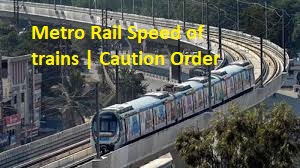Examination of Trains Duties of Train Operator of Metro Rail
Examination of Trains Duties of Train Operator of Metro Rail – (1) Each train shall be examined by a competent person from the Rolling Stock Maintenance department before being offered for passenger service.
(2) The examination shall ensure that all functions of the train are working correct layand in particular safety devices, such as:
(i) cab signaling.
(ii) safety brake circuits.
(iii) train radio communication.
(iv) head and tail lights.
(v) Display Panel of Train Control and Monitoring System or Train Integrated Management System, whatever name given;
(vi) brake gears.
(vii) isolating cock ties intact.
(viii) miniature circuit breaker and safety switch seals intact. and
(ix) any other item specified under special instructions.
(3) The competent staff shall sign a certificate of safety test indicating duration of its validity, which shall remain in the leading cab in the direction of departure.
(4) The Train Operator who runs the train from the depot shall check that the certificate is up to date and currently valid before moving the train and he shall also check the head lights, the tail lights, the marker lights and the speedometer of the train.
Duties of a Train Operator –(1) The Train Operator shall pay immediate attention and obey every signal and shall always be vigilant and cautious and keep a sharp look out.
(2) When a Train Operator, not working under Coded manual mode, approaches a fixed signal at ‘on’ or in ‘defective’ position, he shall not pass a fixed signal that refers to his train, unless after bringing his train to a stop, he is either given a written authority by the Station Controller to proceed past such signal or is authorised by the Operations Control Center or the Traffic Controller on train radio in accordance with special instructions.
(3) The Train Operator shall not operate the train at higher than the maximum authorised speed.
(4) The Train Operator shall be alert for changing rail conditions, and shall exercise extra care when operating in areas which may be affected by grease, oil, water or other substance, which could cause running rails to become slippery and shall adjust the train speed accordingly.
(5) When closing the train doors, the Train Operator shall observe the platform end, as far as practicable, and prevent the closing doors from striking boarding passengers.
(6) If the doors are obstructed or the ‘doors closed’ indication is not received, the Train Operator shall reopen the doors and close them again.
(7) In trains operating under Automatic Mode, the Train Operator shall start the train after closing the doors, and all further progress to the next station and the opening of doors there takes place automatically, unless manual opening of doors is selected.
(8) In trains not operating under Automatic Mode, the Train Operator shall drive the train, observing and obeying cab signals, to the next station and shall stop the train at the appropriate stopping mark, and the doors of the train shall not be opened until the train has come to a complete stop and the platform screen doors, where provided, can be opened manually from the local panel provided near the cab on the platform.
(9) If a train stops short of its proper stopping place, even in Automatic Mode, the Train Operator shall manually drive the train to its proper stopping place, and the doors of the train shall not be opened until the train has come to a complete stop and the platform screen doors, where provided, can be opened manually from the local panel provided near the cab on the platform.
(10) If a train stops beyond its normal stopping place but with the doors still on the platform, the Train Operator shall contact the Traffic Controller to take his permission for reversing so as to align the train at proper stopping place. After reversing the doors may be opened manually and passengers allowed to alight and/or board.
(11) If the train stops beyond the end of the platform, the Train Operator shall seek instruction from the Traffic Controller and if the traffic Controller can prevent the following train from approaching the platform by using the signaling controls, he may do so and then authorise the train at the platform to reverse until all doors are at the
platform and train is correctly positioned at stopping place. Otherwise, an announcement shall be made to the passengers and the train may proceed to the next station without opening the doors, and if the train is the last train of the day, the train may be reversed on instruction of the Traffic Controller and stopped at the normal stopping place. If the train can not be reversed, then the passengers may be allowed to disembark from the train by opening selected doors of the train by the exterior emergency doors control.
(12) (i) If a passenger emergency alarm is operated in the train, the Train Operator shall try to establish voice communication with the location by intercom or public address, and he shall try to establish the reason for the operation of alarm but, unless there is a clear and immediate danger to the train and its passengers, he shall continue to the next station before taking any action.
(ii) the Train Operator shall inform on radio the Traffic Controller in the Operation Control Center and Station Controller of the station at which the train stops about operation of the passenger emergency alarm.
(iii) In case of no passenger response for operated emergency alarm, the Train Operator can reset passenger emergency alarm with the approval of Traffic Controller.




I wanne apply for train operator
My qualifications is 12
Sai sager kamothe navi mumbai